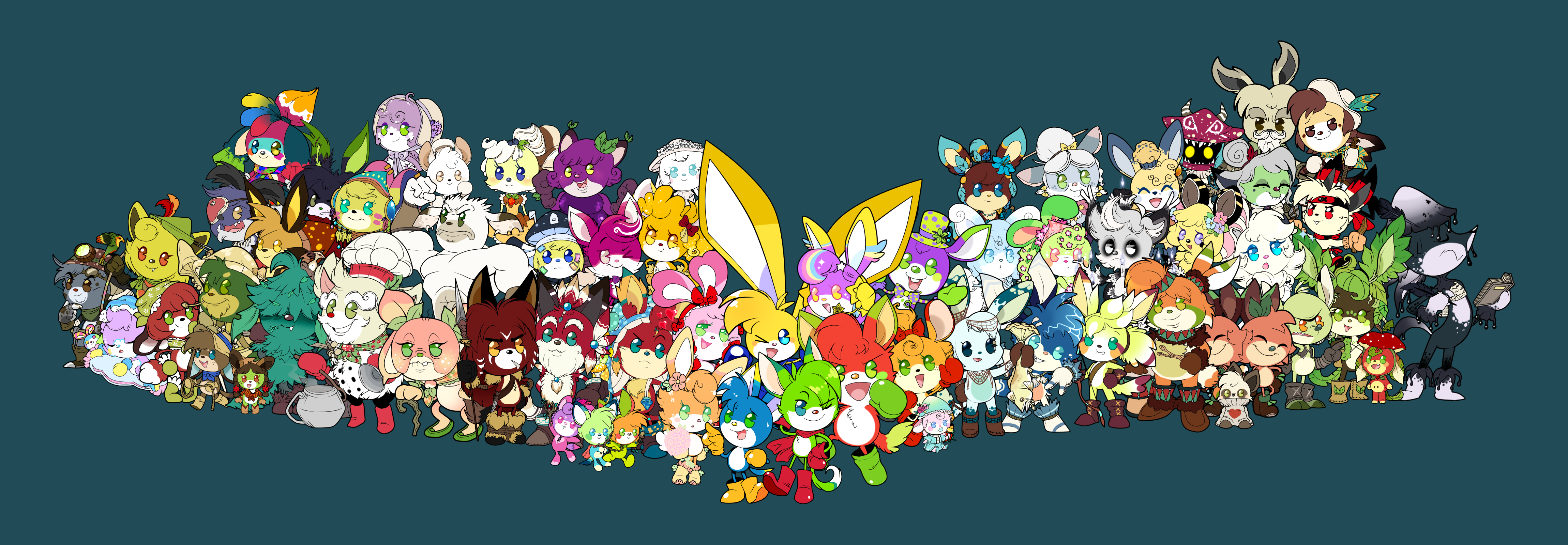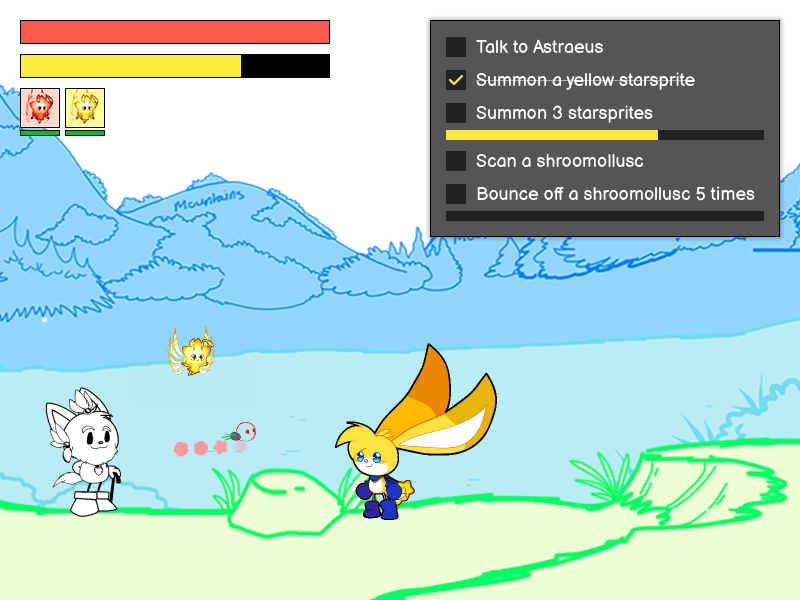Kuparkuke colours
Published by James on 25/10/2022Yesterday, we released a short article on kuparkukes.
In that article, we explained that kuparkukes are a species from the planet Fungaia. They’re intelligent mammals and they’re widespread, found on nearly all of Fungaia’s continents. They’re a social species, who form tribes and make their homes inside great, hollow mushrooms. They keep to themselves, and they’re left alone… for the most part. Nevertheless, they’ve achieved plenty, and that’s without needing to ever leave their beloved Fungaia. I’d go as far as to say they put us humans to shame in more ways than one!
But there’s also a load that we didn’t explain in that article. Although we’re relatively new to sharing things, kuparkukes have been in the works for a long time. Chelsey first created Kinoko in 2011, and others – like Neemal and Kupette – soon followed in 2013. Over the last eleven years, we’ve had a lot of time to think about this species: how they live, what they do, and so on. Since much of this is not yet set in stone, we’ve decided to share what we’ve got in a series of blog posts. This week, we want to talk about kuparkuke colours!
Every kuparkuke has a thick coat of fur. Although it varies by race (more on that in the future), the colour of this fur can vary wildly. Some come in more ‘predictable’ colours, like beige, brown, or white. Some come in hues like red, purple, and green. Others come in silver, or even gold!
Such boldly-coloured kuparkukes are a sight to behold, but these coats aren’t just for show. It was decided early on that kuparkukes should be coloured according to their personality. Of course, kuparkuke personalities aren’t that simple. A kuparkuke’s personality is complex, and they may have many traits – some of them conflicting. All the same, you can tell quite a bit about a kuparkuke simply by looking at their fur. I suppose you can think of this as their core nature, which influences every other part of their psyche.
A non-exhaustive list
Whilst this is far from a complete list, here are a few of the colours we’ve discussed to date…
Red kuparkukes
Red kuparkukes are perhaps best described as feiry. They are strong-minded and passionate in all things. This gives red kuparkukes a reputation for being angry and explosive, but it’s not that they are short-tempered. It’s just that they care a lot about the things they stand for.
Orange kuparkukes
Orange kuparkukes are stubborn by nature and quick to irritate. They have strong beliefs and their views are slow to change. They always do what’s right, even when the right thing doesn’t always endear them to the tribe. They’re endlessly devoted to their friends, but they’ve a way of attracting enemies, too.
Yellow kuparkukes
Yellow kuparkukes are optimists. People often take this to mean yellow kuparkukes are always happy, but it’s more that they take a glass half-full view to all aspects of life. There is no mountain too high for the yellow kuparkuke, nor is there any burden too heavy to bear.
Green kuparkukes
Green kuparkukes are naturally insecure. They’re cursed by low self-esteem, which makes them envious of all those they consider ’better’ than themselves. Their insecurity makes many of them second-guess themselves, whilst other green kuparkukes are prone to overcompensation.
Blue kuparkukes
Blue kuparkukes are best-described as being a bit ‘dry’. They’re said to take things more seriously than other kuparkukes, and they have a more logical and reasoned way of looking at things. They’re more down-to-earth than most, but they’re also prone to worry.
Purple kuparkukes
Purple kuparkukes are something of an enigma. They’re the wildcards of their tribes, often carrying hidden natures and revealing surprise talents, even in old age. They’re as sociable as any other, but at the same time they’re really quite mysterious. They’re often described as ‘dark horses’.
Magenta kuparkukes
Magenta kuparkukes are self-assured. They tend to be completely confident in everything they do. This makes many of them natural-born leaders, and comfortable with being in the spotlight. It also makes many of them arrogant. When a magenta kuparkuke is good at something, they know it.
White kuparkukes
Amongst all their kind, white kuparkukes are the purest. Although it’s uncommon for them to actually act on it, other kuparkukes may be deceitful, prideful, or even vengeful. White kuparkukes stand above such vices. They see the best in everything, they’re unfailingly kind, and they’re honest to a fault.
Pink kuparkukes
It’s all about love for the pink kuparkuke. Whether it be for their tribe, their friends, or that illusive ‘special someone’, pink kuparkukes have big hearts and a lot of love to give. They’re the best, most uplifting friends you could ask for, and they make even better partners.
Cyan kuparkukes
Cyan kuparkukes are drawn to peace and tranquility. They’re great lovers of sand and water, and they often have a gift for playing woodwind instruments, producing gentle sounds that carry softly on the breezes. They’re often found in quiet places where they can be alone with their thoughts.
Crimson kuparkukes
Crimson kuparkukes are hard-skinned and gruff. Whilst other kuparkukes may wear their hearts on their sleeves, crimson kuparkukes are guarded with their emotions. They don’t let their feelings get in their way, making them good at the jobs other kuparkukes are too squeamish to do.
Olive kuparkukes
Olive kuparkukes are considered green-fingered and outdoorsy. Come rain or sunshine, olive kuparkukes are the first to rise and start their day. They enjoy getting their paws dirty and make excellent farmers. They have a knack for working the earth, and they understand nature better than most.
Brown kuparkukes
By themselves, brown kuparkukes are considered the runts of their tribes. They eat more than their fair share, and they rarely excel in anything that others don’t. What they shine best at is teamwork. They’re the worker bees of their tribes - get them on a team, and they can achieve anything.
Grey kuparkukes
Grey kuparkukes are perhaps best-described as gloomy or dreary. It isn’t that they’re sad all the time. They just tend to have more negative outlooks than most. They prefer to plan for the worst than to hope for the best. They’re fascinated by the ‘bleaker’ things in life, like death.
Silver kuparkukes
Silver kuparkukes value their independence. When they can be left to their own devices, they make excellent craftsmen and their work ethic is second-to-none. They’re less comfortable with work that requires team effort. They do their best work when they are left alone and undisturbed.
Gold kuparkukes
Gold kuparkukes are some of the rarest around, and they know it. They’re so rare, they typically come around once in a generation or less. They’re treated as special by their tribes because of this, and it can be difficult for a gold kuparkuke not to let it go to their head. They’re often arrogant and spoiled.
Black kuparkukes
Black kuparkukes are even rarer than gold – in fact, they’re considered an ill omen. Most ‘black’ kuparkukes are in fact just an extremely dark form of another colour, so very little is known about the true kind. Tales tell of brooding creatures of the night, with razor-sharp fangs and claws, and big round eyes which glow brighter than the moonlight.





